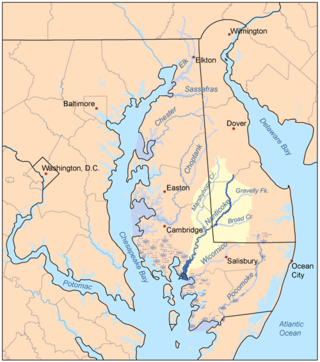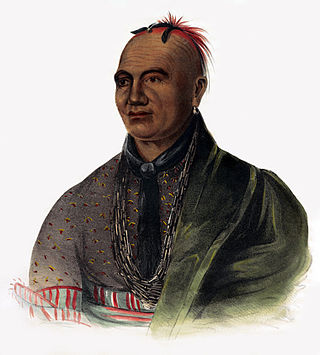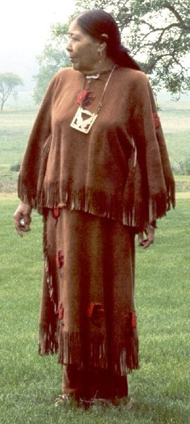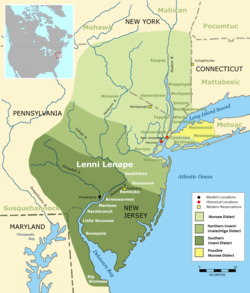
The Lenape also called the Leni Lenape, Lenni Lenape and Delaware people, are an indigenous peoples of the Northeastern Woodlands, who live in the United States and Canada. Their historical territory included present-day northeastern Delaware, New Jersey, the Lehigh Valley and other regions of eastern Pennsylvania, New York City, western Long Island, and the lower Hudson Valley. Today, Lenape people belong to the Delaware Nation and Delaware Tribe of Indians in Oklahoma; the Stockbridge–Munsee Community in Wisconsin; and the Munsee-Delaware Nation, Moravian of the Thames First Nation, and Delaware of Six Nations in Ontario.

Lenapehoking is widely translated as 'homelands of the Lenape', which in the 16th and 17th centuries, ranged along the Eastern seaboard from western Connecticut to Delaware, and encompassed the territory adjacent to the Delaware and lower Hudson river valleys, and the territory between them.

The Delaware languages, also known as the Lenape languages, are Munsee and Unami, two closely related languages of the Eastern Algonquian subgroup of the Algonquian language family. Munsee and Unami, spoken aboriginally by the Lenape people in the vicinity of the modern New York City area in the United States, including western Long Island, Manhattan Island, Staten Island, as well as adjacent areas on the mainland: southeastern New York State, eastern Pennsylvania, New Jersey, Connecticut, Maryland, and Delaware.

Unami was an Algonquian language spoken by the Lenape people in the late 17th century and the early 18th century, in what then was the southern two-thirds of New Jersey, southeastern Pennsylvania and the northern two-thirds of Delaware, but later in Ontario and Oklahoma. It is one of the two Delaware languages, the other being Munsee. The last fluent speaker in the United States, Edward Thompson, of the Delaware Tribe of Indians, died on August 31, 2002. His sister Nora Thompson Dean (1907–1984) provided valuable information about the language to linguists and other scholars.

Munsee is an endangered language of the Eastern Algonquian subgroup of the Algonquian language family, itself a branch of the Algic language family. Munsee is one of the two Delaware languages. It is very closely related to the Unami Delaware, but the two are sufficiently different that they are considered separate languages. Munsee was spoken aboriginally in the vicinity of the modern New York City area in the United States, including western Long Island, Manhattan Island, Staten Island, as well as adjacent areas on the mainland: southeastern New York State, the northern third of New Jersey, and northeastern Pennsylvania.

The Nanticoke people are a Native American Algonquian people, whose traditional homelands are in Chesapeake Bay and Delaware. Today they live in the Northeastern United States and Canada, especially Delaware; in Ontario; and in Oklahoma.

Indigenous peoples of the Northeastern Woodlands include Native American tribes and First Nation bands residing in or originating from a cultural area encompassing the northeastern and Midwest United States and southeastern Canada. It is part of a broader grouping known as the Eastern Woodlands. The Northeastern Woodlands is divided into three major areas: the Coastal, Saint Lawrence Lowlands, and Great Lakes-Riverine zones.

The Christian Munsee are a group of Lenape, an Indigenous people in the United States, that primarily speak Munsee and have converted to Christianity, following the teachings of Moravian missionaries. The Christian Munsee are also known as the Moravian Munsee or the Moravian Indians, the Moravian Christian Indians or, in context, simply the Christian Indians. As the Moravian Church transferred some of their missions to other Christian denominations, such as the Methodists, Christian Munsee today belong to the Moravian Church, Methodist Church, United Church of Canada, among other Christian denominations.

The Eastern Algonquian languages constitute a subgroup of the Algonquian languages. Prior to European contact, Eastern Algonquian consisted of at least 17 languages, whose speakers collectively occupied the Atlantic coast of North America and adjacent inland areas, from what are now the Maritimes of Canada to North Carolina. The available information about individual languages varies widely. Some are known only from one or two documents containing words and phrases collected by missionaries, explorers or settlers, and some documents contain fragmentary evidence about more than one language or dialect. Many of the Eastern Algonquian languages were greatly affected by colonization and dispossession. Miꞌkmaq and Malecite-Passamaquoddy have appreciable numbers of speakers, but Western Abenaki and Lenape (Delaware) are each reported to have fewer than 10 speakers after 2000.
The Nanticoke Lenni-Lenape people are a tribal confederation of Nanticoke of the Delmarva Peninsula and the Lenape of southern New Jersey and northern Delaware. They are recognized by the state of New Jersey, having reorganized and maintained elected governments since the 1970s. They have not yet achieved federal recognition.
The Kechemeche were a Lenni Lenape tribe of Native Americans that lived in the area generally known today as the southern portion of Cape May County, New Jersey, an area bounded on one side by the Atlantic Ocean and the Delaware Bay on the other.
Mohican is a language of the Eastern Algonquian subgroup of the Algonquian language family, itself a member of the Algic language family. It was spoken in the territory of present-day eastern New York state and Vermont by the Mohican people but is believed to have gone extinct for seven decades. However, since the late 2010s, the language is being revived, with adults learning the language, and children being raised having Mohican as their first language.

Piscataway is an extinct Algonquian language formerly spoken by the Piscataway, a dominant chiefdom in southern Maryland on the Western Shore of the Chesapeake Bay at time of contact with English settlers. Piscataway, also known as Conoy, is considered a dialect of Nanticoke.
Sicomac is an unincorporated community located within Wyckoff, in Bergen County, New Jersey, United States.

The Delaware Tribe of Indians, formerly known as the Cherokee Delaware or the Eastern Delaware, based in Bartlesville, Oklahoma, is one of three federally recognized tribes of the Lenape people in the United States, the others being with the Delaware Nation based in Anadarko, Oklahoma, and the Stockbridge-Munsee Community of Wisconsin. More Lenape or Delaware people live in Canada.

Nora Thompson Dean, also known as Weenjipahkihelexkwe, which translates as "Touching Leaves Woman" in Unami, was a member of the Delaware Tribe of Indians. As a Lenape traditionalist and one of the last fluent speakers of the southern Unami dialect of the Lenape language, she was an influential mentor to younger tribal members and is widely cited in scholarship on Lenape culture.

Indian Mills, formerly known as Brotherton, is an unincorporated community located within Shamong Township in Burlington County, New Jersey, United States. It was the site of Brotherton Indian Reservation, the only Indian reservation in New Jersey and the first in America, founded for the Lenni Lenape tribe, some of whom were native to New Jersey's Washington Valley.
Pidgin Delaware was a pidgin language that developed between speakers of Unami Delaware and Dutch traders and settlers on the Delaware River in the 1620s. The fur trade in the Middle Atlantic region led Europeans to interact with local native groups, and hence provided an impetus for the development of Pidgin Delaware. The Dutch were active in the fur trade beginning early in the seventeenth century, establishing trading posts in New Netherland, the name for the Dutch territory of the Middle Atlantic and exchanging trade goods for furs.

The Minisink or Minisink Valley is a loosely defined geographic region of the Upper Delaware River valley in northwestern New Jersey, northeastern Pennsylvania and New York.

Washington Valley is an unincorporated community in the Whippany River valley within Morris Township in Morris County, New Jersey.











